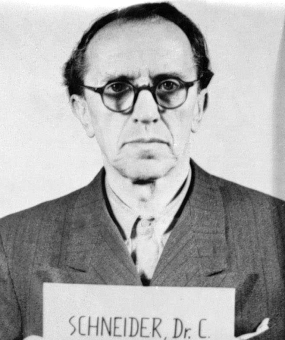Christian Schneider (1887–1972)

© National Archives, Washington, DC
“On my visit to IG Auschwitz, I saw concentration camp prisoners in action, for example, transporting things, carrying bags of cement, digging ditches. The prisoners wore striped suits and were guarded by SS men. There were some gaunt, worn-out men among them, while part of them still looked quite good.”[1]
Christian Schneider was born in Kulmbach on November 19, 1887, the son of the electrician August Schneider and his wife, Babette (née Weiss). After attending school in Kulmbach and Nuremberg, he began studying chemistry in Erlangen in 1907, receiving his doctoral degree in 1911 with a dissertation on “The Effect of Benzanilidimide Chloride on Hydrazine and Its Derivatives.” After that, he worked as an assistant at the Mining Academy (Bergakademie) in Freiberg until 1912, when he was hired by BASF to work with Alwin Mittasch in the nitrogen lab. In 1914, he served in World War I and was wounded. In 1919, he became an assistant of Carl Krauch in Leuna, and this marked the start of his rapid ascent of the career ladder: in 1921 he was made an authorized signatory, in 1923 a director, and in 1924 the deputy manager of the Ammoniakwerke Merseburg, where he assumed the position of plant manager in 1936.
In 1928, Christian Schneider was named an alternate member of the managing board of I.G. Farben. After the National Socialist seizure of power, he became a sponsoring member of the SS in 1933/34.
In 1938, Christian Schneider became a full member of the managing board of I.G. Farben and took over the running of Product Division I—nitrogen, oils, and mines—as the successor of Carl Krauch. In addition, he headed the Central Personnel Department. In 1939, he became the official chief of plant managers for I.G. Farben, and as such he also was responsible for the workforce of I.G. Auschwitz. In 1940, Schneider became the chief counterintelligence operative of the I.G., and one year later he was named a “military economy leader” (Wehrwirtschaftsführer). He was married twice, to Frieda Butzengeiger and to Hedwig Breidenbach, and had four children in all.
On June 22, 1945, he was “evacuated”[3] from Leuna to the U.S. zone of occupation, where he was accused in 1947 in the I.G. Farben Trial at Nuremberg, charged with plundering, enslavement, and membership in the SS. After his acquittal, he became a member of the supervisory boards of Süddeutsche Kalkstickstoff-Werke AG Trostberg and Rheinauer Holzhydrolyse-GmbH, Mannheim. Christian Schneider died on May 5, 1972, in Ziegelhausen near Heidelberg, where he spent his final years.
(SP; transl. KL)
















